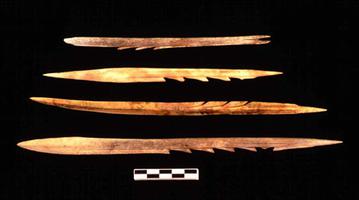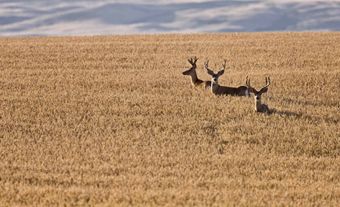In 1997, two sheep hunters on a mountaintop in southern Yukon came across a field of frozen caribou dung in a region where no caribou had been seen for more than 100 years. This discovery initiated one of the most exciting archaeological projects in Canada in decades. Unusually warm summer temperatures experienced in all of North America in the 1990s caused alpine ice patches in the Coast Mountain ranges of southern Yukon to melt rapidly. As the alpine ice receded, preserved dung, bone and antler of the once extensive caribou herds were revealed. Also emerging from the ice were the well preserved and nearly complete weapons of the ancient caribou hunters, which are rarely seen in the world of archaeology.
For millennia, indigenous hunters in the Yukon have pursued caribou into the mountains in the summer months. Escaping the heat and harassing insects, small herds of caribou could always be found on alpine ice patches. Over thousands of years of caribou hunting, weapons were lost or discarded in the soft summer snow and were soon incorporated into the permanent ice on the mountaintop.
Since the first discovery of the ice patch sites in 1997, more than 180 ancient hunting weapons have been recovered from 23 ice patches in southern Yukon, in addition to more than 1,400 animal bones. Many of these artifacts preserve their wood, bone, antler, sinew and feather components which otherwise rarely survive in the archaeological record. Moreover because these artifacts are organic, they can be directly dated by radiocarbon techniques (unlike stone tools). Thus far, more than 200 radiocarbon dates have been obtained on artifacts and the remains of ancient animals found in the ice patches. The oldest artifact is a segment of a hunting dart, which is more than 9000 years old.
The Yukon ice patch collection contains some of the finest archaeological examples of throwing darts (sometimes called atlatl darts) and prehistoric bows and arrows found in the New World. It has provided important insights for archaeologists into the technology and chronology of ancient hunting weaponry. Throwing dart weaponry for hunting persisted from about 9000 to 1200 years ago, when it was abruptly and entirely replaced by the bow and arrow. Some of the darts and arrows in the ice patch collection are so well preserved they still possess points, ochre paint, fletching and sinew bindings.
The exceptional organic preservation in the southern Yukon ice patches has made possible a number of other scientific studies in areas such as caribou genetics, changes in caribou diet, palaeoenvironmental studies, and atmospheric heavy metal contamination.
Since the first Yukon discoveries in 1997, archaeological ice patches have been found at numerous alpine locations around the world, including Alaska, Northwest Territories, British Columbia, Colorado, Wyoming, Norway and Switzerland.
The southwest Yukon ice patches are located within or in close proximity to the traditional territories of six south Yukon First Nations: Carcross/Tagish, Champagne and Aishihik, Kluane, and Kwanlin Dün First Nations and the Ta'an Kwächän and Teslin Tlingit Councils. Caribou figure prominently in the oral history and traditional stories of all the First Nations and the oral traditions are informing the interpretation of the human history associated with the alpine ice patches. The six First Nations have been partners in the field and scientific investigations since the inception of the project. The First Nations recognize the research as a chance for their citizens, especially youth, to be involved in the study of their history and to link science with community.

 Share on Facebook
Share on Facebook Share on X
Share on X Share by Email
Share by Email Share on Google Classroom
Share on Google Classroom







